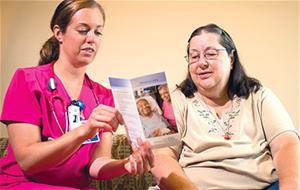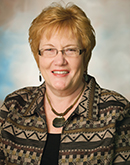By JULIE MINDA
For many people, tending to, or even touching, a loved one who is in the hospital can be an intimidating prospect.
"When (visitors) go into a hospital, they know that patients are cared for by nurses and doctors — so many people believe you shouldn't touch a patient who's in the hospital," said Paula Hafeman, chief nurse executive of Hospital Sisters Health System — Eastern Wisconsin Division. "It's also scary for people, because they see all these IVs and other equipment. They don't want to touch the patient and have an alarm go off."

Briana Kudick, an advanced practice nurse, discusses the Partners in Caring program with caregiver Renee Belongia. Belongia enrolled in the program in early July during her husband's stay in the intensive care unit at HSHS St. Vincent Hospital in Green Bay, Wis.
But, the welcome touch of a loved one is reassuring, and there are many basic grooming and caregiving tasks that loved ones can safely do for hospitalized patients. And a patient whose family had provided care or assistance with tasks of daily living prior to the hospitalization may feel more comfortable receiving care from a loved one. HSHS' four Eastern Wisconsin Division hospitals formally encourage and support caregiving on the part of family and friends through a Partners in Caring program. They have found that getting loved ones involved in patient care is improving recovery times and easing patients' return home, according to information from HSHS.
Hafeman said the vast majority of tasks that the care partners undertake in the hospital are "low-key but still important — and they still need to be done" — tasks like assisting with bathing, feeding and grooming. Tasks that are more involved, such as wound care, are taught and modeled by a nurse, who then watches the family caregiver perform the function that person will take on when the patient goes home.
In an era of short hospital stays, many patients may need some assistance when they return home. Barbara Hennes, a critical care services nurse at HSHS St. Vincent Hospital in Green Bay, Wis., said encouraging families to become involved in their loved ones' care prior to leaving the hospital can ease the patient's transition home.
Shared responsibility
Jeanne O'Connor, a seasoned nurse at HSHS St. Vincent Hospital, heard about the Partners in Caring model's creation and use at Banner Desert Medical Center in Mesa, Ariz., and her enthusiasm grew the more she learned.
"What was exciting to me was with Partners in Caring, when the patient comes in we could immediately start to think about how we're preparing them for discharge" in partnership with the people who likely would care for them at home. "In the past, we usually would discharge patients and give them and their families instructions." During the patient's stay, there wasn't much hands-on learning by family members, she said
O'Connor and the HSHS St. Vincent Hospital nurse practice council tailored the Arizona program for their hospital and implemented it about six years ago, getting buy-in by involving nurses throughout the facility. HSHS St. Vincent Hospital has since introduced it to the three other hospitals in HSHS' Eastern Wisconsin Division, and information on the program has been shared with HSHS' other 10 hospitals.
Team player
The program is for inpatients exclusively. Nursing staff determine whether a particular patient may benefit from the program, based on that patient's condition, situation and needs. The patient — in collaboration with his or her family or support person — determines which family members or friends should be invited to participate. A member of the nursing staff then explains the program to the potential participant or participants. A patient can have more than one designated partner, but in practice most people have only one.
The partners' names are included in the list of the patient's team members, a list noted on a white board in each patient's room. Hafeman said partners are treated as a member of that care team, including taking part in "bedside handoffs" to next shift nursing staff.
The partners do not perform any tasks that require a medical or nursing license or advanced training in a hospital setting, such as administering medications. The partners can perform the types of tasks they would at home upon discharge, such as changing wound dressings and assisting patients with walking.
Nurses conduct the same assessments on patients with partners that they conduct with patients without them; and nurse staffing levels are the same for patients with partners and those without. All of this is according to Hafeman, who said, "The partner does not take the place of a staff member, they truly work with us — they help us — we work together as a team."

Hafeman
No-go zones
The implementation team for the program has worked through a few challenges.
There was an incident in which a partner attempted to use a lifting device to move a patient without staff assistance — resulting in a patient fall and ICU care. Participants now sign an agreement that states what they will and won't do. For example, only nursing staff can use lifting devices.
Another issue that arose was that some partners were not living up to their commitments, according to O'Connor. For in-stance, some partners who had agreed to stay with restless and confused patients over a certain time period to calm those patients fell asleep during their shifts. While O'Connor said that although such a situation does not negatively impact patient care — nursing staff still check on patients with partners as often as they check on those without partners — it may necessitate working with the patient and partner to find an appropriate way for the partner to assist the patient.
Hafeman and O'Connor said the vast majority of partners have been successful, with patients and partners reporting feeling involved in, and informed of, the patient's care.
Caregiver maintenance
Renee Belongia signed up to take part in the Partners in Caring after her husband, Glen, was admitted to HSHS St. Vincent Hospital's ICU in early July — the most recent of his multiple hospitalizations.
Belongia said although she had already felt comfortable providing hands-on care to her husband while he is in the hospital, the program has enabled her to feel more integrated with his clinicians. She no longer feels — as she sometimes did in the past — like she is "underfoot" of the nursing staff. Belongia said the program also helps ensure she takes care of herself. Partners receive a card for free hot meals in the cafeteria or through room service. With the meal card at hand, she remembers to get a hot meal several times a day.
O'Connor said Partners in Caring enables the hospital's clinicians and the patient's loved ones to form a "complete circle" around the patient.
And Hafeman said, "We find that family members are eager to care for their loved one in the hospital, just as they would at home. It brings both the patient and the family comfort."
Copyright © 2015 by the Catholic Health Association of the United States
For reprint permission, contact Betty Crosby or call (314) 253-3477.